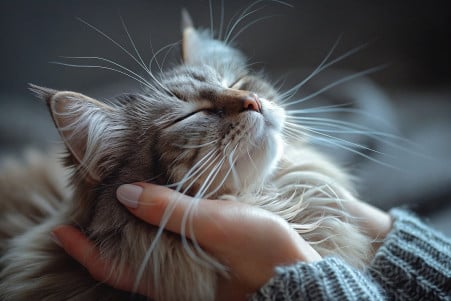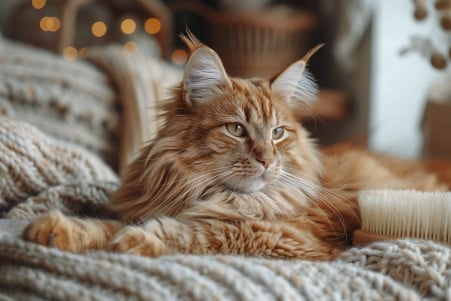How Much Do Bengal Cats Shed? Grooming Tips for These Exotic Felines
6 May 2024 • Updated 6 May 2024

Are you constantly covered in cat hair, or are Bengal cats low shedders? While Bengal cats aren't as high shedding as some other breeds, they are moderate shedders year-round. That said, their short, fine coats shed less than the fur of long-haired cats. Still, Bengal cats have two shedding seasons a year, and during these times, regular grooming is necessary to keep shedding under control.
This article will look at the grooming needs, environmental factors, and genetic factors that contribute to how much Bengal cats shed. Knowing why Bengal cats shed will help you make sure you're doing everything you can to keep their beautiful coats looking their best while keeping the hair they shed to a minimum.
Do Bengal cats shed a lot?
The Hypoallergenic Myth: Are Bengal Cats Actually Safe for People With Allergies?
Many breeders claim that Bengal cats are hypoallergenic or less likely to cause allergic reactions. However, the Bengal Cat Connection notes that no cat breed can be considered 100% hypoallergenic. This is because all cats produce the Fel d 1 protein, which is an allergen found in cat saliva, urine, and dander.
Bengals are considered hypoallergenic due to their single-layer coats, which means they shed less and therefore spread less saliva and dander, which carry allergens, around the home. In addition, their short, fine fur is easy to groom, which means that the allergen Fel d 1 is less likely to be spread around the home. However, some individual Bengals may still cause allergic reactions, so it's best to spend time with a cat before bringing it home.
To reduce the risk of allergies when living with Bengals, regular grooming with deshedding tools, air purifiers, and a high-quality diet can help minimize the risk of exposure to allergens. While not hypoallergenic in the truest sense of the word, Bengals may be a good option for people with allergies who are willing to take these precautions.
Things That Impact How Much Bengal Cats Shed
One of the most obvious factors that can impact how much a Bengal cat sheds is age, as kittens and older cats may shed more due to changes in their life stages. The Royal Bengal Cattery says that Bengal kittens often have a "fuzzies" phase between 6-9 weeks where their coat patterns are less distinct, but this will resolve as they get older.
Seasonal changes can also cause Bengal cats to shed more as the weather gets warmer and the days get longer. Untamed explains that even though Bengals only have one layer of fur, they can still have seasonal changes that lead to more shedding.
In addition to these factors, stress, a poor diet, and underlying health conditions like allergies and hormonal imbalances can make a Bengal cat's shedding worse. Sploot Vets says that if you can identify and treat the causes of excessive shedding, such as stress or a bad diet, you may be able to reduce the amount of hair your cat loses.
That said, each Bengal cat will have its own shedding pattern based on its genetics and the conditions it's exposed to. As BlindBengal points out, even though Bengals are generally known for shedding less than other cats, if they do shed a lot, it could be a sign of an underlying problem that needs to be resolved.
How to Groom and Manage Shedding in Bengal Cats
Frequent brushing with a deshedding tool is a must for Bengal cats, especially during shedding seasons. The Bengal Cat FAQ notes that Bengals may shed more than usual for no reason, and that adding Omega-3 supplements to their diet can help stop the shedding.
Bathing Bengal cats every 2-3 months can also help get rid of loose hair and dander. Aumuca notes that using the right brush regularly can help reduce shedding in Bengal cats. It's also important to make sure that they are eating a diet that is high in protein and free of fillers to ensure that their skin and coat are as healthy as possible.
Cats.com explains that cod liver oil, evening primrose oil, and fish oils are all supplements that may improve coat quality and reduce shedding in cats. In addition, making sure that your cat is in a low-stress environment and that any medical issues are being treated will help you manage Bengal shedding.
By making sure that you have the right grooming schedule and other factors in place, you can help make sure that your Bengal cat doesn't shed more than necessary and that you can keep their coat in the best shape possible.
Coat Development: When Do Bengal Cats Shed the Most?
Bengal kittens are born with a coat that may have solid spots or rosettes that will become more defined as they grow, Sakura Bengals reports. Kittens may even go through a 'fuzzies' stage at 6-9 weeks where their coat pattern becomes less defined, but this usually resolves itself.
In adulthood, Bengal cats have a short, sleek coat that is low shedding compared to many other breeds. BlindBengal points out that while some Bengal breeders claim their cats don't shed, Bengals do shed, but it is less than long-haired cats. Especially for younger cats under two years old, regular grooming can help reduce the amount of fur that is shed.
On the other hand, older Bengal cats may experience more shedding. This may be due to the normal aging process or it could be a sign of an underlying condition. As Catster reports, if your Bengal is shedding more than usual, it could be a sign of an underlying issue like a nutritional deficiency or stress. By keeping an eye on your cat's coat and making changes to their grooming routine, you can help ensure that shedding is kept to a minimum at every stage of their life.
Genetic Health Issues That May Affect Bengal Cat Shedding
Bengal cats are prone to a few genetic health issues, including progressive retinal atrophy (PRA) and hypertrophic cardiomyopathy (HCM), notes WebMD. PRA is a condition that causes blindness as the retina degenerates, and HCM is a potentially fatal heart condition that can result in heart failure.
In addition to genetics, stress, poor diet, and other underlying health issues like kidney disease or cancer can cause Bengal cats to shed more than usual. Catster explains that allergies, hormonal imbalances, and skin issues can also make shedding worse.
Regular vet visits and addressing any health issues as soon as they arise can help keep shedding under control for Bengal cats. The Bengal Connection stresses the importance of breeders testing for genetic health issues to minimize the chances of health problems in these unique cats.
Conclusion: Learning to Love Bengal Cats' Shedding
While it's a common misconception, Bengal cats do shed, although it's less than many other breeds of domestic cats. As Sean Lewis writes in Medium, Bengal cats have a shorter, finer coat, which makes their shedding less noticeable. That said, it's important to note that almost all cats will shed at least a little.
There are a few things that can impact how much Bengal cats shed. For example, younger cats tend to shed less, and shedding may increase as cats get older. Untamed explains that Bengal cats also have seasonal shedding cycles, which means that more hair will be shed in the spring and fall. Shedding can be managed with a healthy diet and a stress-free environment, while excessive shedding may be a sign of an underlying health condition.
To keep shedding to a minimum, it's best to brush Bengal cats regularly, feed them a high-quality diet, and bathe them occasionally. As Catster's article explains Bengal cats are low-shedding, but not no-shedding, so it's important for their owners to keep up with grooming and cleaning to keep their homes free of fur.
With the right approach, Bengal cat owners can enjoy their pets' gorgeous coats while keeping shedding in check. Learning to accept and manage the unique grooming requirements of Bengal cats is part of the fun of owning these exotic felines.


